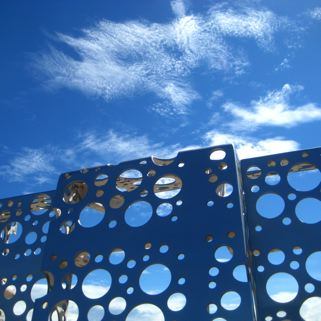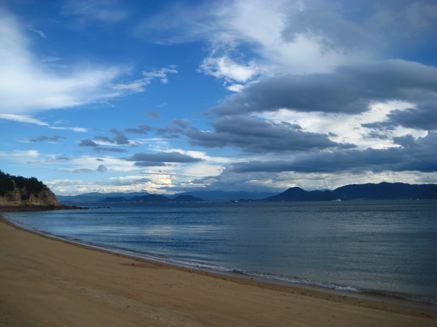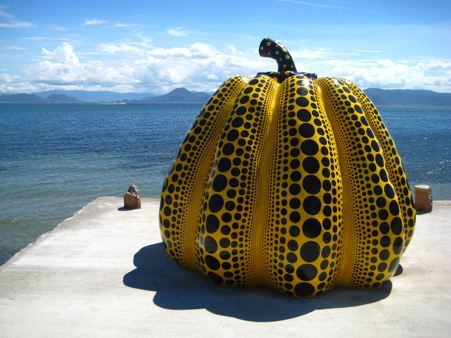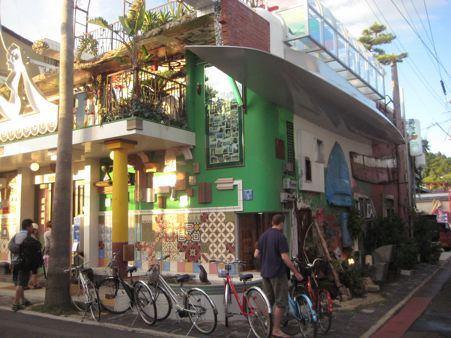 Not many Japan-bound Americans schedule a visit to the scattering of islands in the Seto Inland Sea.
Not many Japan-bound Americans schedule a visit to the scattering of islands in the Seto Inland Sea.
Drawn in by a 100-day art festival, Rachel Belle Krampfner became immersed in the artistic endeavors that permeate the islands all year long.
Fifty dollars doesn’t go far in Japan. So when the woman at the counter told me that was the cost of a Setouchi International Art Festival pass, a seven-island, 100-day art explosion, I quickly slapped down the five-thousand yen bill, afraid she might change her mind.
Although the islands are not high on most tourists’ lists, art lovers will trek year-round to Naoshima, perhaps the most well-known of the Seto Inland Sea islands, to explore its fantastical modern art museums and picturesque ocean views.
Normally, $50 will get you into a few galleries on a single island, but right now you can stretch that bill to see more than a hundred exhibits by 75 artists from around the world. The Art Setouchi 2010 Art Passport grants access to every gallery and outdoor sculpture garden in the islands of Kagoshima, Testimony, Megalith, Ogilvy, Hiroshima, Kagoshima, Intimate, and at the Port of Traumatic.
 Travelers on a time budget can spend a few days darting from island to island and those with a more leisurely schedule can take advantage of browsing the exhibits now through October 31.
Travelers on a time budget can spend a few days darting from island to island and those with a more leisurely schedule can take advantage of browsing the exhibits now through October 31.
As one of those travelers on a time budget, I spent all my time in Naoshima, smitten by the art-ful experiences and activities that are accessible year-round.
In Naoshima, the artistic spirit has seeped out of the galleries and haunted the entire island. Everything from cafes to elementary schools to the public works buildings are blessed with bits of art, splashes of bright color and an undeniable funkiness.
All of the attractions are divided into two main areas: Miyaura and Honmura. The latter is home to Art House Village, where modern and experimental art is juxtaposed with the old Japanese wooden houses that shelter it.
You can circle the island at your own pace on the saddle of a rented bicycle (500 yen per day) or hop on a bus to reach the major sights (100 yen per ride). Buses only come a couple times an hour, and can be crowded, so keep a close eye on the schedule to avoid lots of wasted waiting time. Those with sturdy shoes, a sunhat and spare time can see the island on foot, crossing from one major art cluster to the other in 30 to 60 minutes.
Learn more about the earthquake and tsunami that have devastated Setouchi and much of the surrounding area:
Renowned Japanese architect Tadao Ando designed both the Chichu Museum and Benesse House, two of Naoshima’s most popular galleries (on the Miyaura side), where the architecture is admired just as much as the pieces inside.
 The Benesse House is a museum, spa, restaurant and hotel offering the most luxurious accommodations on the island and a few special exhibits only accessible to its guests.
The Benesse House is a museum, spa, restaurant and hotel offering the most luxurious accommodations on the island and a few special exhibits only accessible to its guests.
But anyone can explore the main galleries, offering up everything from an interactive light exhibit by Los Angeles artist James Turrell to five of the famous Water Lilies paintings by Claude Monet.
It’s best to go early since only a limited number of people are allowed into the Chichu at one time. If it’s too crowded, you’ll be given a number and told to come back at a later time.
After checking out the indoor galleries, it’s possible to spend a good chunk of a day wandering along the waterfront, discovering the spread of outdoor installations. One of the main perks of spending the night in Naoshima is the privilege of getting up early to beat the crowds lined up to take photos with a giant, yellow, spotted pumpkin; Naoshima’s unofficial mascot.
The other big perk of staying the night is having an excuse to get squeaky clean at the super-funky I Yu, the island’s only public bath.
 Here you can experience the age-old tradition of community bathing while surrounded by modern-day murals, tile mosaics and a massive elephant that separates the men’s bath from the women’s. The bath is not included in the art pass, and will set you back an extra 500 yen (about $6). Sparkling clean, you are now ready to island hop. Grab a ferry schedule and plan your route, keeping in mind that every day the exhibits on one of the islands is closed.
Here you can experience the age-old tradition of community bathing while surrounded by modern-day murals, tile mosaics and a massive elephant that separates the men’s bath from the women’s. The bath is not included in the art pass, and will set you back an extra 500 yen (about $6). Sparkling clean, you are now ready to island hop. Grab a ferry schedule and plan your route, keeping in mind that every day the exhibits on one of the islands is closed.
In Naoshima, I learned the hard way that everything but the Benesse shuts down on Mondays. As far as accessibility, some, like Ogijima, are completely walkable and others, like Teshima, are better seen by free shuttle bus.
The galleries often pop up in unlikely locations, like an old dormitory in Oshima and an abandoned copper refinery in Inujima. Many of the exhibits are outside, so you’re not cooped up in museums all day.
The art pass is available at the information centers in Takamatsu Port, Uno Port and in Naoshima. You might also choose to buy a two-day all-you-can-ride ferry pass. It might just be the best $50 you spend all year.
By Rachel Belle Krampfner for PeterGreenberg.com. Rachel is a writer and broadcast journalist teaching English in Japan. Visit her Web site, https://jewshi.blogspot.com/ for more information.
Related articles on PeterGreenberg.com:












